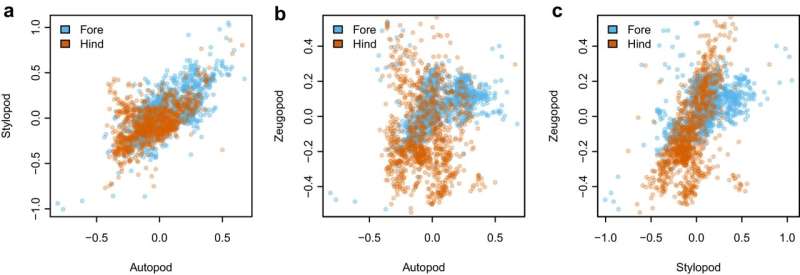This article has been reviewed according to Science X's editorial process and policies. Editors have highlighted the following attributes while ensuring the content's credibility:
fact-checked
peer-reviewed publication
trusted source
proofread
Study shows birds that have evolved greater complexity are less biodiverse

A new study of the evolution of birds shows that as their skeletons become more complex, they also decrease in diversity, with fewer species as they become more specialized in their niches. The findings, published in Nature Communications, show a correlation between skeleton complexity and bird diversity for the first time, and help biologists better understand why biodiversity varies across the birds.
Researchers at the Milner Centre for Evolution at the University of Bath looked at 983 species across all major groups of living birds and measured the complexity of their skeletons by comparing the bones in their fore limbs (wings) and hind limbs (legs).
They found that less complex birds—those with a smaller differences between their fore and hind limbs—had more species diversity than those with higher complexity and a larger difference between their limbs.
For example, birds such as pigeons, gulls and songbirds (passerines) have low skeletal complexity but a high diversity of species living in varied habitats across the world.
At the other end of the spectrum, flamingos, and ostriches have short wings in comparison to their legs, and so have more complex limb skeletons. Groups with more complex skeletons may occupy smaller niches and are less able to subdivide those niche spaces in order to produce new species.
While evolution can produce forms with lower complexity, these findings suggest that birds with more complex skeletons have become more specialized over time and so more developmentally entrenched. This may make them less likely to evolve back to become simpler again.
Causes of biodiversity
Professor Matthew Wills, from the Milner Centre for Evolution at the University of Bath, said, "We wanted to understand what causes some groups of birds to be species rich and others to be species poor—although ecology obviously plays an important part, it doesn't account for the huge differences we see in biodiversity."
"The received wisdom that there is no direction to evolution—that selection can act in any direction. Our study suggests that, in birds at least, the more they specialize, the less they are able to give rise to new species."
Putting all the eggs in one basket
The researchers also found that birds with more complex skeletons were generally more ecologically specialized, occupying fewer habitats and foraging for food in fewer ways.
Andrew Brinkworth, Ph.D. student at the Milner Centre for Evolution and first author of the paper, said, "Species can evolve to be specialized, and fill very small niches."
"However in doing so, they restrict the number of routes they can evolve further, meaning they are likely to be less resilient to changes in the environment such as those caused by habitat loss, disruption to food chains and climate change."
"From our findings we predict that birds with more complex skeletons and less diversity will be at greater risk of extinction from these changes."
The researchers next plan to test if this pattern is also true in other animals.
More information: Andrew Brinkworth et al, Bird clades with less complex appendicular skeletons tend to have higher species richness, Nature Communications (2023). DOI: 10.1038/s41467-023-41415-2
Journal information: Nature Communications
Provided by University of Bath




















